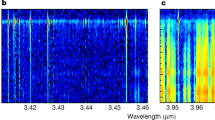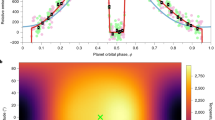Abstract
Temperatures of the outer planet thermospheres exceed those predicted by solar heating alone by several hundred degrees. Enough energy is deposited at auroral regions to heat the entire thermosphere, but models predict that equatorward distribution is inhibited by strong Coriolis forces and ion drag1,2. A better understanding of auroral energy deposition and circulation are critical to solving this so-called energy crisis. Stellar occultations observed by the Ultraviolet Imaging Spectrograph instrument during the Cassini Grand Finale were designed to map the thermosphere from pole to pole. We analyse these observations, together with earlier observations from 2016 and 2017, to create a two-dimensional map of densities and temperatures in Saturn’s thermosphere as a function of latitude and depth. The observed temperatures at auroral latitudes are cooler and peak at higher altitudes and lower latitudes than predicted by models, leading to a shallower meridional pressure gradient. Under modified geostrophy3, we infer slower westward zonal winds that extend to lower latitudes than predicted, supporting equatorward flow from approximately 70° to 30° latitude in both hemispheres. We also show evidence of atmospheric waves in the data that can contribute to equatorward redistribution of energy through zonal drag.
This is a preview of subscription content, access via your institution
Access options
Access Nature and 54 other Nature Portfolio journals
Get Nature+, our best-value online-access subscription
$29.99 / 30 days
cancel any time
Subscribe to this journal
Receive 12 digital issues and online access to articles
$119.00 per year
only $9.92 per issue
Buy this article
- Purchase on Springer Link
- Instant access to full article PDF
Prices may be subject to local taxes which are calculated during checkout




Similar content being viewed by others
Data availability
The data that support the plots within this paper and other findings of this study are available from the NASA Planetary Data System (https://pds-imaging.jpl.nasa.gov/portal/cassini_mission.html) or from the corresponding author upon reasonable request.
Code availability
The equations required to produce our results are available in Methods. However, the horizontal wind code is available from the corresponding author upon request.
Change history
09 April 2020
In the legend of Fig. 1b, ‘UVIS solar (2010)’ has been changed to ‘UVIS solar (2007–2010)’ and ‘Voyager stellar (1983)’ has been changed to ‘Voyager solar and stellar (1980/1981)’.
References
Müller-Wodarg, I. et al. Atmospheric waves and their possible effect on the thermal structure of Saturn’s thermosphere. Geophys. Res. Lett. 46, 2372–2380 (2019).
Müller-Wodarg, I., Moore, L., Galand, M., Miller, S. & Mendillo, M. Magnetosphere–atmosphere coupling at Saturn: 1—Response of thermosphere and ionosphere to steady state polar forcing. Icarus 221, 481–494 (2012).
Larsen, M. & Walterscheid, R. Modified geostrophy in the thermosphere. J. Geophys. Res. 100, 17321–17329 (1995).
Koskinen, T. et al. Saturn’s variable thermosphere from Cassini/UVIS occultations. Icarus 260, 174–189 (2015).
Vervack, R. & Moses, J. Saturn’s upper atmosphere during the Voyager era: reanalysis and modeling of the UVS occultations. Icarus 258, 135–163 (2015).
O’Donoghue, J. et al. The domination of Saturn’s low-latitude ionosphere by ring ‘rain’. Nature 496, 193–195 (2013).
O’Donoghue, J. et al. Observations of the chemical and thermal response of ‘ring rain’ on Saturn’s ionosphere. Icarus 322, 251–260 (2019).
Dougherty, M. et al. Saturn’s magnetic field revealed by the Cassini Grand Finale. Science 362, eaat5434 (2018).
O’Donoghue et al. Conjugate observations of Saturn’s northern and southern H3+ aurorae. Icarus 229, 214–220 (2014).
Miller, S., Stallard, T., Melin, H. & Tennyson, J. H3+ cooling in planetary atmospheres. Faraday Discuss. 147, 283–291 (2010).
Bougher, S. Jupiter Thermospheric General Circulation Model (JTGCM): global structure and dynamics driven by auroral and Joule heating. J. Geophys. Res. 110, E04008 (2005).
Achilleos, N. et al. JIM: a time-dependent, three-dimensional model of Jupiter’s thermosphere and ionosphere. J. Geophys. Res. Planets 103, 20089–20112 (1998).
Gates, W. L. Derivation of the equations of atmospheric motion in oblate spheroidal coordinates. J. Atmos. Sci 61, 2478–2487 (2004).
Li, L. et al. Equatorial winds on Saturn and the stratospheric oscillation. Nat. Geosci. 4, 750–752 (2011).
Li, L. et al. Strong jet and a new thermal wave in Saturn’s equatorial stratosphere. Geophys. Res. Lett. 35, L23208 (2008).
Guerlet, S., Fouchet, T., Bézard, B., Flasar, F. & Simon-Miller, A. Evolution of the equatorial oscillation in Saturn’s stratosphere between 2005 and 2010 from Cassini/CIRS limb data analysis. Geophys. Res. Lett. 38, L09201 (2011).
Militzer, B., Wahl, S. & Hubbard, W. Models of Saturn’s interior constructed with an accelerated Concentric Maclaurin Spheroid method. Astrophys. J. 879, 78–93 (2019).
Koskinen, T. et al. The density and temperature structure near the exobase of Saturn from Cassini UVIS solar occultations. Icarus 226, 1318–1330 (2013).
Lamy, L. et al. Saturn’s northern aurorae at solstice from HST observations coordinated with Cassini’s Grand Finale. Geophys. Res. Lett. 45, 9353–9362 (2018).
Smith, C., Aylward, A., Millward, G., Miller, S. & Moore, L. An unexpected cooling effect in Saturn’s upper atmosphere. Nature 445, 399–401 (2007).
Anderson, J. & Schubert, G. Saturn’s gravitational field, internal rotation, and interior structure. Science 317, 1384–1387 (2007).
Koskinen, T. & Guerlet, S. Atmospheric structure and helium abundance on Saturn from Cassini/UVIS and CIRS observations. Icarus 307, 161–171 (2018).
Abgrall, H. et al. Table of the Lyman band system of molecular hydrogen. Astron. Astrophys. Suppl. 101, 273–321 (1993).
Abgrall, H. et al. Table of the Werner band system of molecular hydrogen. Astron. Astrophys. Suppl. 101, 323–362 (1993).
Abgrall, H., Roueff, E. & Drira, I. Total transition probability and spontaneous radiative dissociation of B, C, B′, and D states of molecular hydrogen. Astron. Astrophys. Suppl. 141, 297–300 (2000).
Yelle, R. et al. Structure of Jupiter’s upper atmosphere: predictions for Galileo. J. Geophys. Res. 101, 2149–2161 (1996).
Iess, L. et al. Measurement and implications of Saturn’s gravity field and ring mass. Science 364, eaat2965 (2019).
Jia, X. et al. Magnetospheric configuration and dynamics of Saturn’s magnetosphere: a global MHD simulation. J. Geophys. Res. 117, A05225 (2012).
Cowley, S., Bunce, E. & O’Rourke, J. A simple quantitative model of plasma flows and currents in Saturn’s polar ionosphere. J. Geophys. Res. 109, A05212 (2004).
Davis, L. & Smith, E. A model of Saturn’s magnetic field based on all available data. J. Geophys. Res. 95, 15257–15261 (1990).
Dyundina, U., Ingersoll, A., Ewald, S. & Wellington, D. Saturn’s aurora observed by the Cassini camera at visible wavelengths. Icarus 263, 32–43 (2016).
Acknowledgements
Z.B. and T.K. acknowledge support from the NASA Cassini Data Analysis Program (80NSSC19K0902). R.W.’s contributions were made at the Jet Propulsion Laboratory, under a contract with NASA (80NM0018D0004). L.E. was supported by the Cassini Project.
Author information
Authors and Affiliations
Contributions
Z.B. performed the analysis, developed analytical tools and wrote the manuscript. T.K. developed analytical tools, conceived of the strategy to infer horizontal winds and provided feedback on the manuscript. I.M.-W. provided guidance on the interpretation of the results, STIM outputs, and conductivity and electric field data. R.W., A.J. and T.K designed the observing campaign and commented on the manuscript. L.E. is the principal investigator of the UVIS instrument, and contributed to UVIS observation campaigns and commented on the manuscript.
Corresponding author
Ethics declarations
Competing interests
The authors declare no competing interests.
Additional information
Peer review information Nature Astronomy thanks Henrik Melin and the other, anonymous, reviewer(s) for their contribution to the peer review of this work.
Publisher’s note Springer Nature remains neutral with regard to jurisdictional claims in published maps and institutional affiliations.
Supplementary information
Supplementary Information
Supplementary Table 1 and Figs. 1–4.
Rights and permissions
About this article
Cite this article
Brown, Z., Koskinen, T., Müller-Wodarg, I. et al. A pole-to-pole pressure–temperature map of Saturn’s thermosphere from Cassini Grand Finale data. Nat Astron 4, 872–879 (2020). https://doi.org/10.1038/s41550-020-1060-0
Received:
Accepted:
Published:
Issue Date:
DOI: https://doi.org/10.1038/s41550-020-1060-0
This article is cited by
-
Global upper-atmospheric heating on Jupiter by the polar aurorae
Nature (2021)
-
Towards a solution to the energy crisis
Nature Astronomy (2020)
-
Cassini Exploration of the Planet Saturn: A Comprehensive Review
Space Science Reviews (2020)



